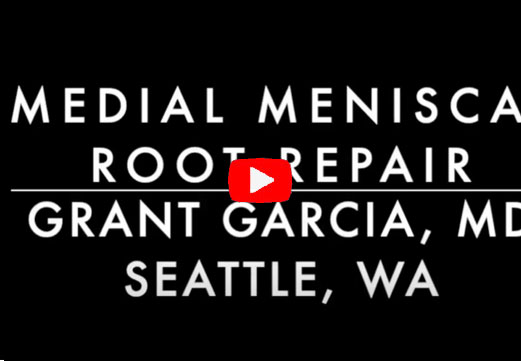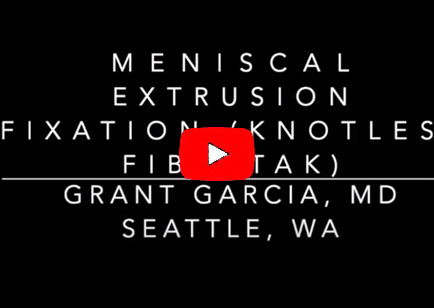Meniscal Root Repair
Dr. Grant H. Garcia Speaks on Meniscal Root Tears & Cutting Edge Treatment
Meniscal Root Tears:
Dr. Garcia’s technique for medial meniscal root repair
Most people know about regular meniscal tears which can be traumatic or degenerative. Meniscal root tears are unique in that they can be fixed at a much older age and have more detrimental effects if missed.
Anatomy:
The meniscus is a cushion of the knee joint. There are two menisci in the knee, medial and lateral. They are connected to your tibia by meniscal roots. You have two roots per meniscus which include anterior and posterior roots. The posterior roots are the most important as this is where a root tear occurs most commonly.
Types of root tears:
Dr Garcia demonstrates his new meniscal extrusion technique to further improve meniscus root repairs
There are a few types of root tears. The first is if a piece of bone pulls off with the meniscus.
The other is a partial tear of the root but most commonly you can fully tear your meniscal root.
What patients get root tears?
There are three main types of root tears. There are tears that occur from normal wear and tear and these usually involve patients with some arthritis in their knee. The second is relatively normal tissue that happens from an accident and the root tears acutely. The third type of tearoccurs in younger patients and these are commonly associated with ACL tears. More recent data associate them with chronic ACL or revision ACL injuries.
Medial root tears are more common in the first two types of root tears. ACL associated tears are more commonly on the lateral side.
What are the symptoms?
Dr. Garcia demonstrates his new technique to further improve meniscus root repair called centralization / an extrusion stitch.
Usually an acute pop in the back of the knee with swelling. After this patient’s develop pain in the back of the knee with swelling, stiffness and reduced motion. In some cases, the pain may improve but generally the pain continues and becomes more achy.
What is the big deal with a root tear?
Tearing your meniscal root is equivalent to removing the ENTIRE meniscus which can have a drastic impact on a patient’s knee. As a result, recent data demonstrates that patients with these tears can have rapid onset of arthritis. Upwards of 50% of patient end of needing a knee replacement in 3-5 years after this injury if it is not addressed promptly.
How does the surgeon determine who has a root tear?
Usually a thorough exam is performed looking for joint line tenderness, swelling and pain in the back of the knee. After this an MRI is performed to full evaluate for a root tear and determine how long it has been torn.
What are the treatment options?
Dr. Garcia demonstrates his new technique to improve meniscus root repairs using a knotless extrusion stitch.
For many patients a repair is suggested to slow do the progression of arthritis and reduce pain. For patient who are overweight or have a lot of arthritis already they do very poorly with fixation. Those that are surgical candidates a surgery is performed drilling a small tunnel in the back of the knee and pulling the meniscus back to its position. This is anchored down with strong sutures to prevent it from pulling out.
What are the outcomes?
Overall the outcomes are good. If performed in younger patient’s success rates have been seen as high as 90%. In patients with degenerative root tears success rates are 75-80% depending on the age of the root tear. Chronic root tears (>1 year) tend to do slightly worse since they are stuck in poor position for longer.
What is the recovery?
After root repair, patients need to limit their weight on the leg for 6 weeks. The full return to sports is roughly 5 months. For the first 8-weeks patients will wear a brace to push on the knee and reduce the stress on the root repair. For more information visit Dr. Garcia’s post-op rehab protocols.
-
Our technique for ACL reconstruction with a lateral meniscus root repair.
-
My technique on one of the first isolated meniscal extrusion repairs in Washington State.
-
Testimonial after lateral meniscal root repair
-
Dr. Garcia’s - Anterior Meniscal Root Repair Technique




















